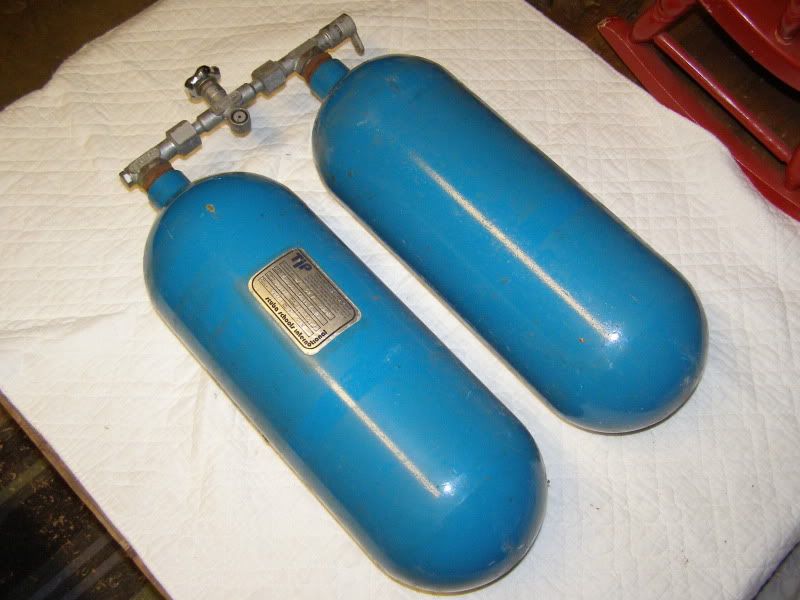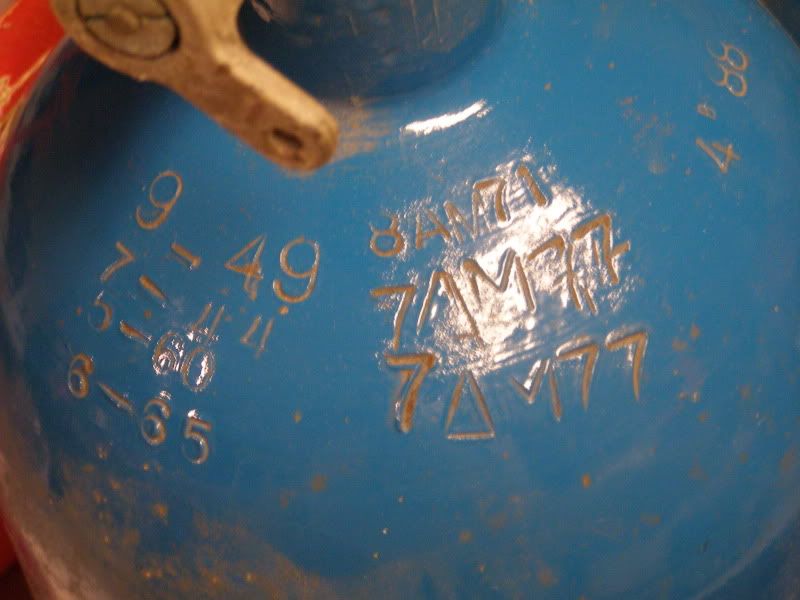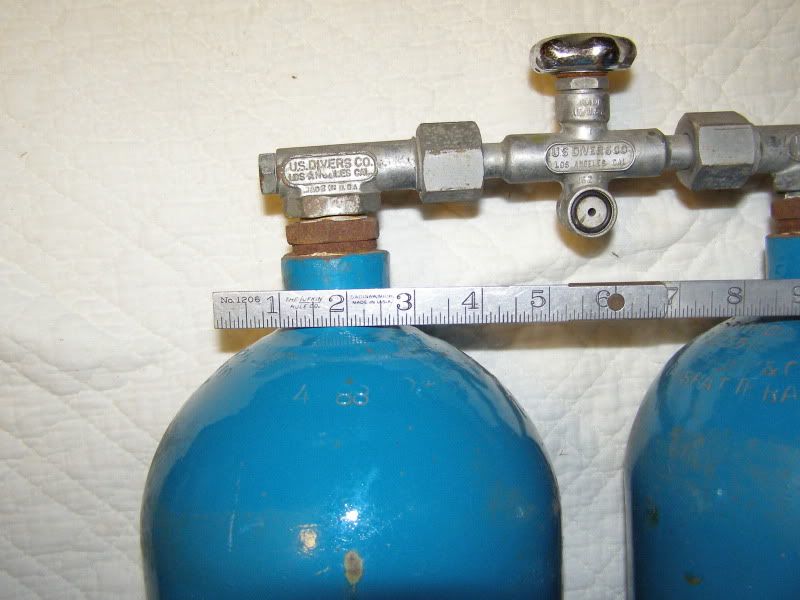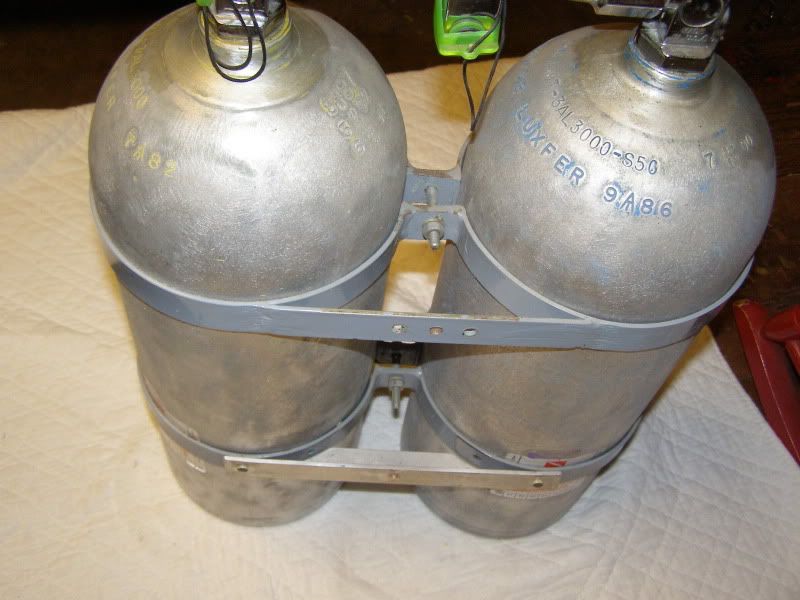- captain
- Plank Owner
- Posts: 1440
- Joined: Mon Jul 04, 2005 11:32 am
- Location: LaPlace, LA
Re: 1950's Navy Tank
That, more than likely was a CO2 fire extinguisher tank or life raft inflation cylinder converted to scuba use. Commonly done back in the 50's when there was an abundance of surplus items from WW II. The non shat stamp means the tank was wire wrapped originally for protection from fragmentation.
Captain
- antique diver
- Master Diver
- Posts: 2210
- Joined: Sun Dec 10, 2006 12:50 pm
- First Name: Bill
- Location: North-Central Texas
Re: 1950's Navy Tank
Andy, don't give up yet. Put a good light inside the tank and see how much rust or pitting is actually apparent... then get someone you can trust who is familiar with inspections to look. I have had rust particles come out of a cylinder that ultimately cleaned up ok inside, but you might need to get it tumbled to really tell the condition. Too bad your local "dive boutique" isn't a real Dive Shop with people that are knowledgeable and care. That's hard to find these days.AndyB wrote:Thanks Captian,
I'd love to get it back in the water with my Trademark Aqualung on it. But, when I took the valve of and turned it upside down some rust particles came out! And also, no LDS around here would touch it with a ten foot pole
I don't recall seeing the material and pressure stamps on your tank... is there a line that says 3AA 1800, or maybe 3A 1800? Hopefully 3AA for chrome moly steel if I recall. I hope that's not the line that is stamped over.
The older I get the better I was.
-
VINTAGESCUBA
Re: 1950's Navy Tank
Yes,I have some.There worthless.Old oxygen tanks made into scuba. 
- antique diver
- Master Diver
- Posts: 2210
- Joined: Sun Dec 10, 2006 12:50 pm
- First Name: Bill
- Location: North-Central Texas
Re: 1950's Navy Tank
Well, that's true vintage diving equipment! Tanks are just presssure vessels made for compressed gasses, and many an early diver took cylinders that were initially "used for" Oxygen or CO2 and put them to use for diving. Why not? I did as a young diver. They are indeed "vintage diving equipment" because they were in such common use, and some of us still have and use some to this day as appropriate gear from a given era such as the 1950's.VINTAGESCUBA wrote:Yes,I have some.There worthless.Old oxygen tanks made into scuba.
I am not advocating lax safety procedures when using these cylinders. They should be properly inspected and tested to modern industry standards. I have my own compressors, but still follow these standards. I leave off the inspection stickers on my old cylinders to remain "vintage correct", and keep a record in my equipment log. I sometimes also use a Brother P-Touch label maker to make a 3/8" wide label with the insp date on it, placing it on an inconspicuous place on the cylinder as a reminder, but I try to keep these where no one sees them.
It probably helps that I used to be in the dive business here for 31 years, but the LDS and some nearby dive sites fill my cylinders because I have explained to them my attention to modern standards. Also I have taken some of the personnel on dives with vintage gear, and most have really appreciated and enjoyed it. Ya got to treat them nice if that's how you want to be treated.
The older I get the better I was.
- 8dust
- Master Diver
- Posts: 551
- Joined: Wed Aug 05, 2009 11:39 am
- Location: Nashville's North Shore
Re: 1950's Navy Tank
So, I think I've got Andy's yellow one beat.
Look what I just happened into the other day.

I haven't even had a chance to get my newly built 53's wet yet, and along come these.
Check out the markings... oldest hydro is 7-44!!!
Sounds pretty VINTAGE to me!

from what I understand from the post above, the W K & Co with the shield with the H inside means they were made by the Walter Kiddie Company, the US Govt means they were Military, and the Non Shatterable maens they were wrapped in wire,...

what about the "7 Delta 7M 77"? and am I going to get any grief about the ICC stamp in place of a DOT? I've never seen any 38's in person, so maybe dumb question, but the necks on these look pretty big? like they actually need the insert to get down to 3/4"? thought most of them were 1/2"? do you think they are tapered?

any thoughts on getting them pulled apart? without damaging anything?
The fellow I bought them from said that when he got the 38's, they had these bands installed with a Voit snugpac on them? (he later put them on these 50's, which I got too ) they aren't old Voit bands are they? didn't see anything like them in the catalogues... the cross-bar on the bottom is a very well done aluminum rivited patch, but the rest are a welded steel. Almost no rust at all... if they are home made, they are really really good in my opinion. Anyone ever see anything like them?
) they aren't old Voit bands are they? didn't see anything like them in the catalogues... the cross-bar on the bottom is a very well done aluminum rivited patch, but the rest are a welded steel. Almost no rust at all... if they are home made, they are really really good in my opinion. Anyone ever see anything like them?


any other thoughts on how I should approach the 38's, or the 50's for that matter, would be greatly appreciated. Nice Sherwood manifold on the 50's as a bonus!
Look what I just happened into the other day.

I haven't even had a chance to get my newly built 53's wet yet, and along come these.
Check out the markings... oldest hydro is 7-44!!!
Sounds pretty VINTAGE to me!

from what I understand from the post above, the W K & Co with the shield with the H inside means they were made by the Walter Kiddie Company, the US Govt means they were Military, and the Non Shatterable maens they were wrapped in wire,...

what about the "7 Delta 7M 77"? and am I going to get any grief about the ICC stamp in place of a DOT? I've never seen any 38's in person, so maybe dumb question, but the necks on these look pretty big? like they actually need the insert to get down to 3/4"? thought most of them were 1/2"? do you think they are tapered?

any thoughts on getting them pulled apart? without damaging anything?
The fellow I bought them from said that when he got the 38's, they had these bands installed with a Voit snugpac on them? (he later put them on these 50's, which I got too


any other thoughts on how I should approach the 38's, or the 50's for that matter, would be greatly appreciated. Nice Sherwood manifold on the 50's as a bonus!
Freddo
NAVED member #201
NAVED member #201
- antique diver
- Master Diver
- Posts: 2210
- Joined: Sun Dec 10, 2006 12:50 pm
- First Name: Bill
- Location: North-Central Texas
Re: 1950's Navy Tank
Unfortunately most dive beautiques will not want to help you with your cool vintage cylinders... but that doesn't mean that they are not useable with the proper inspections and testing that a few "real dive shops" might help you with.
The neck of these cylinders are most likely 1" tapered pipe threads (NPT or NGT), nothing unusual there. Modern hydro facilities have the adapters to test them.
I have some similar cylinders that I take to a hydro facility without a problem. You may just have to bypass the dive beautiques and go straight to the source for hydros.
Too bad you aren't near Dallas-Fort Worth area, since I have friends here that could probably help you. Don't throw them out or give them to some dive beautique dumbass.
Keep them, but if you use them do it only after proper inspection and testing!
The neck of these cylinders are most likely 1" tapered pipe threads (NPT or NGT), nothing unusual there. Modern hydro facilities have the adapters to test them.
I have some similar cylinders that I take to a hydro facility without a problem. You may just have to bypass the dive beautiques and go straight to the source for hydros.
Too bad you aren't near Dallas-Fort Worth area, since I have friends here that could probably help you. Don't throw them out or give them to some dive beautique dumbass.
Keep them, but if you use them do it only after proper inspection and testing!
The older I get the better I was.
-
crimediver
- Master Diver
- Posts: 412
- Joined: Tue Jul 12, 2005 7:38 am
- Location: Richmond, Va
Re: 1950's Navy Tank
I find it it is better to remove the manifold and bushing before sending the tank out for hydro. Some uninformed shops will fuss or reject a cylinder with a bushing. I have a similar non-shat tank with a bushing that adapts it for use with a 1/2" npt valve and have had no problem getting it hydroed once I took the bushing out. I was told by another shop they could not hydro it with a bushing, blah, blah , blah...
Looking at the pics of the manifold makes me believe it was a nice custom built manifold done as a do-it yourself project.
Looking at the pics of the manifold makes me believe it was a nice custom built manifold done as a do-it yourself project.
- 8dust
- Master Diver
- Posts: 551
- Joined: Wed Aug 05, 2009 11:39 am
- Location: Nashville's North Shore
Re: 1950's Navy Tank
although the tanks look really good, and the manifold doesn't look too bad, the bushings look kinda rusty... Wondering where I could fing replacements and what they should be made of? steel like what's in there? galv. steel? brass? If I need to use some penetrating oil to remove, will tumbling clean out any oil that gets inside?
Freddo
NAVED member #201
NAVED member #201
- kgehring
- Master Diver
- Posts: 563
- Joined: Wed Jun 29, 2005 7:44 pm
- Location: Indianapolis
- Contact: Website
Re: 1950's Navy Tank
Bushings can be replaced. Here is a link:
http://www.mcmaster.com/#4443k757/=92vduw
http://www.mcmaster.com/#4443k757/=92vduw
http://www.scubamuseum.com
Over 400 vintage regulators in my collection
Over 400 vintage regulators in my collection
- antique diver
- Master Diver
- Posts: 2210
- Joined: Sun Dec 10, 2006 12:50 pm
- First Name: Bill
- Location: North-Central Texas
Re: 1950's Navy Tank
Oil can be removed later if residue gets into tanks. Main concern when removing bushings is to leave the valve in place or snugly install a 1/2" NPT pipe plug before trying to remove the bushing from tank. Plug is the preferred method. Otherwise you risk crushing the bushing due to lack of internal support, making it very difficult to remove. For replacement bushing be sure not to use regular plumbing fittings such as the galvanized steel you mention. Get a high pressure rated bushing of steel or brass.8dust wrote:although the tanks look really good, and the manifold doesn't look too bad, the bushings look kinda rusty... Wondering where I could fing replacements and what they should be made of? steel like what's in there? galv. steel? brass? If I need to use some penetrating oil to remove, will tumbling clean out any oil that gets inside?
It might be difficult to find a HP brass version due to thin material of a 1" to 1/2" bushing.
The older I get the better I was.
- 8dust
- Master Diver
- Posts: 551
- Joined: Wed Aug 05, 2009 11:39 am
- Location: Nashville's North Shore
Re: 1950's Navy Tank
thanks to you both!
Yes, I see that the brass ones, at least @ McMaster, are only rated to 200psi! which as they are chrome plated, is probably what I would have blundered in to buy. Looks like the SS is the way to go. Is there a reason I couldn't go 1" to 3/4" to be able to use a manifold with an o-ring seal instead of a second layer of tape?
Yes, I see that the brass ones, at least @ McMaster, are only rated to 200psi! which as they are chrome plated, is probably what I would have blundered in to buy. Looks like the SS is the way to go. Is there a reason I couldn't go 1" to 3/4" to be able to use a manifold with an o-ring seal instead of a second layer of tape?
Freddo
NAVED member #201
NAVED member #201
- captain
- Plank Owner
- Posts: 1440
- Joined: Mon Jul 04, 2005 11:32 am
- Location: LaPlace, LA
Re: 1950's Navy Tank
It is odd to see bushings used with a newer 3/4 inch valve and it looks like they didn't use an O ring and just forced the 3/4' straight thread manifold into a 3/4" NPT bushing, not a good idea and surprised they didn't leak. The manifold may have been re-threaded to 3/4" NPT.8dust wrote:So, I think I've got Andy's yellow one beat.
Look what I just happened into the other day.
I haven't even had a chance to get my newly built 53's wet yet, and along come these.
Check out the markings... oldest hydro is 7-44!!!
Sounds pretty VINTAGE to me!
from what I understand from the post above, the W K & Co with the shield with the H inside means they were made by the Walter Kiddie Company, the US Govt means they were Military, and the Non Shatterable maens they were wrapped in wire,...
what about the "7 Delta 7M 77"? and am I going to get any grief about the ICC stamp in place of a DOT? I've never seen any 38's in person, so maybe dumb question, but the necks on these look pretty big? like they actually need the insert to get down to 3/4"? thought most of them were 1/2"? do you think they are tapered?
any thoughts on getting them pulled apart? without damaging anything?
The fellow I bought them from said that when he got the 38's, they had these bands installed with a Voit snugpac on them? (he later put them on these 50's, which I got too) they aren't old Voit bands are they? didn't see anything like them in the catalogues... the cross-bar on the bottom is a very well done aluminum rivited patch, but the rest are a welded steel. Almost no rust at all... if they are home made, they are really really good in my opinion. Anyone ever see anything like them?
any other thoughts on how I should approach the 38's, or the 50's for that matter, would be greatly appreciated. Nice Sherwood manifold on the 50's as a bonus!
The bushing would have to be custom made to work with a 3/4" straight thread O ring manifold and there is not a lot of metal to work with.
The most common set up was a 1" to 1/2" NPT bushing and a 1/2" NPT valve. You may end up ruining the bushings getting them out and would have to get new ones made. Better to find a 1/2" NPT manifold and either stainless steel or forged steel bushings.
Captain
- captain
- Plank Owner
- Posts: 1440
- Joined: Mon Jul 04, 2005 11:32 am
- Location: LaPlace, LA
Re: 1950's Navy Tank
Andy, one thing I just noticed is that there appears to be some over stamping of previous stamping, that may present an issue to a hydro shop.
Captain
- 8dust
- Master Diver
- Posts: 551
- Joined: Wed Aug 05, 2009 11:39 am
- Location: Nashville's North Shore
- captain
- Plank Owner
- Posts: 1440
- Joined: Mon Jul 04, 2005 11:32 am
- Location: LaPlace, LA
Re: 1950's Navy Tank
Normally yes, it is tapered. You will not find straight pipe thread at regular pipe supply sources. For special applications such as scuba it is straight. Right off I can't think of any other applications where straight pipe thread is in general use.
Captain
Who is online
Users browsing this forum: No registered users and 116 guests